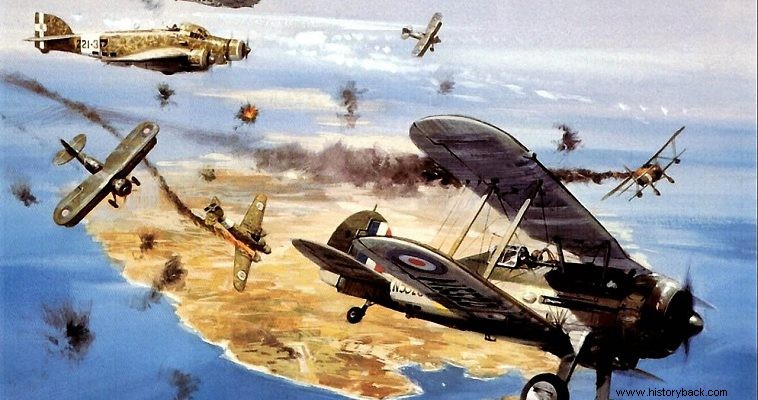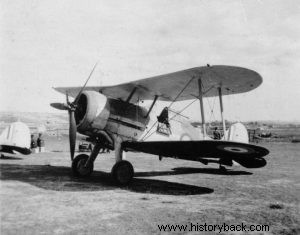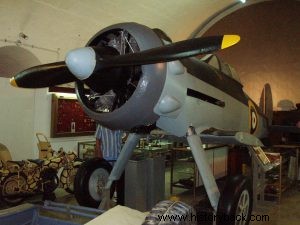
TheGloster Gladiator, the RAF's last biplane fighter, was already a flying anachronism when it entered service. Despite this, he acted and even remarkably in the initial stage of the Second World War. He first saw action in distant China fighting against the Japanese. But where the humble biplane became famous was Malta.
The Gladiator first flew in 1934 as the prototype S.S.37. Flew as Gladiator I in 1936 and entered RAF fighter squadrons in 1937. 767 built in total Gladiator I, Gladiator II and Sea Gladiator aircraft. Of these, 216 were exported or donated to foreign countries (Belgium, China, Egypt, Finland, Greece, Iraq, Ireland, Latvia, Lithuania, Norway, Portugal, South Africa and Sweden).
Malta
Gladiators achieved their first shootdown in China in 1938. They also performed exceptionally well in Finland in Finnish and Swedish hands. But where their action became legendary - and for reasons of war propaganda - was Malta.
The three Gladiators "Faith", "Hope" and "Charity" (Faith, Hope and Love, by definition, from the martyred daughters of Agia Sophia), became synonymous with the island's resistance to the "powers of darkness", on the Axis. The truth is of course less romantic, but it is a fact that for a time the few Gladiators found in Malta carried the burden of defence.
On 18 April 1940 the aircraft carrier Glorius had landed some Sea Gladiators in Malta. These aircraft formed an ad hoc swarm. Sources do not agree on the number of aircraft stating four, six, eight or even 10. Some of these were used as spare parts sources.
The first pilots were Lt. Martin, Lt. Barge, and Lt. Lt. Woods. On 10 June 1940 Italy declared war on the Allies and the squadron was put on alert. The next day the first Italian bombers appeared. Against the formations of the Italian Savoia S.79s, two Gladiators took off with Barge and Woods.
Gladiators damaged a bomber and a Macchi C.200 chaser escorting the bombers. The Gladiators were trying to intercept the fast Italian bombers while dealing with their usually superior Italian fighters. Two Gladiators were destroyed in accidents but two more were assembled.
On the afternoon of June 22 two Gladiators with Barge and Woods shot down an S.79 bomber. The next day the Gladiators were called upon to deal with another raid of bombers which were escorting them in pursuit. In the ensuing engagement Barge shot down a C.200 chaser.
On 31 July Woods shot down an Italian FIAT CR.42 biplane fighter. In the same air battle, however, the Gladiator of Lt. Gen. Barber was shot down, and he was seriously injured. The Gladiator in question was the only one lost to enemy action.
In the meantime, the first Hurricanes arrived on the island and together with the Gladiators formed the 261st Squadron. The Gladiador's next success came in early November when Bartz and two other pilots engaged eight Italian CR.42s. In the dogfight one Italian was shot down and one more was damaged.
After the arrival of more and more modern destroyers, the Gladiadors were withdrawn from active service and reduced to support roles. Their last combat mission to Malta was in January 1942. It was a reconnaissance mission. It is worth noting that another ad hoc Gladiator squadron operated in the Mediterranean on the aircraft carrier Eagle, writing pages of glory.
The Gladiators fought to the best of their ability in Malta against an absolutely superior enemy. Although they achieved few shootings, they nevertheless showed the opponents that Malta was not defenseless, they intercepted several enemy raids and above all they sharply raised the morale of the British armed forces, but also of the population of the island, showing that they would not let the Italians bombard them unmolested, what if the Gladiators were few and "old-fashioned" side-by-side chasers.
Gloster Gladiator Technical Features
Type:Single-seat, biplane pursuit
Length:8.38m
Wingspan:9.85m
Engine:Bristol Mercury VII A, IX, IXS of 840 hp
Weight:1,565 kg empty, 2,155 full.
Top speed:407 kilometers per hour
Radius:708 km
Initial rate of climb:700 meters per second
Ceiling:10,600 m
br />Armament:The first 71 two Browning machine guns and two 0.303in Lewis machine guns, the next 4 0.303in (7.7mm) Browning machine guns.

Gladiator N5520 “Faith”, 1940, with three-blade propeller from a Blenheim bomber.

"Faith" today, without wings, in the museum of Malta.
